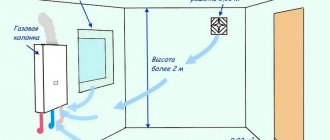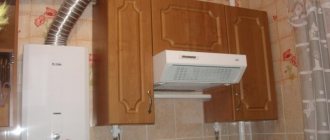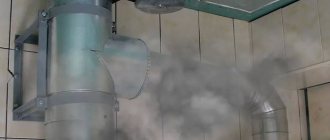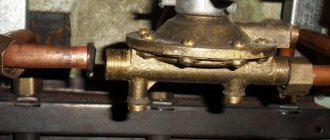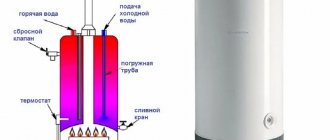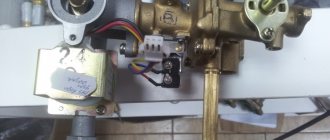A gas water heater is one of the most durable household appliances. With proper use, it can last up to 15 years or more. But in practice, this period may be shorter, which entails the need to purchase new equipment. This is due not only to the physical wear and tear of the components, but also to the obsolescence of the device.
For you, like most owners, replacing a gas water heater in an apartment raises many questions and doubts about the correctness of the actions, doesn’t it? What standards and requirements must be observed so as not to break the law and not put your life and property in danger?
In this article, we will give tips and recommendations on replacing a gas water heater, preparing the necessary documents, and will help you avoid mistakes and miscalculations when installing the device. We will provide our material with diagrams, examples of documents and visual photos, as well as videos.
Installation standards and requirements
All types of work with gas supply, which involve installing tees, supplying a gas pipe and installing shut-off valves on a gas pipe, should be entrusted to specialists from an organization that has the appropriate license. If this provision is ignored, you may be forced to pay a fine.
Column installation work must be divided into two categories. The first involves installing the device from scratch. The second is replacing the old device with a new one. In the first case, you will need to supply a gas pipe to the location of the water heater. You should also take care of the availability of the project. This work is carried out by gas utilities in each region or by a company with a license for a certain type of activity. In this case, you cannot do anything on your own.
If the project is ready and everything is agreed upon, then you can do some of the work yourself, saving money. It is necessary to begin manipulations after drawing up the project and obtaining approvals and permits. The installation standards for the described equipment are regulated by SP 42-101-2003, which sets out the provisions for the construction and design of gas distribution systems. One should also take into account the SNiP act 42-01-2002, which talks about gas distribution systems.
When replacing a gas water heater, you must make sure that the ceiling height is at least 2 m. There must be a chimney in the room. Its diameter is 120 mm. These do not include “stuffers” in apartments. The water supply must maintain a pressure of 0.1 atmospheres. Geysers should not be installed in bathrooms.
Installation must be carried out on walls made of non-combustible materials. The appliance should not be placed above a gas stove. If this cannot be avoided, then the distance should be more than 10 cm. If the column that was used in the bathroom needs to be replaced and complies with technical standards, then installation is allowed in the same room.
Procedure for processing documents
If the installation of a new geyser is planned in the same place and its capacity does not exceed the old one, then such a replacement is carried out according to the sketch, within the framework of the existing project.
To do this, you will need the following list of documents and their copies:
- Gas supply project.
- A certificate confirming ownership of an apartment or house. For the private sector - an act on the right to use a land plot.
- Registration certificate of an apartment or house.
- Report on checking the condition of smoke and ventilation ducts. To receive it, first submit an application to the service authorized in your region (housing and communal services, Ministry of Emergency Situations, firefighters).
- Technical data sheet for a new water heater.
- Application for replacement of a gas water heater without changing its location and power.
Requirements may vary by region.
An example of an application form provided to the gas service for replacement of a dispenser. In some regions, additional requirements may be put forward for the installation of a gas alarm, the prohibition of turbocharged ventilation systems, and others.
In all other cases, for example, when you need to move the water heater to another location or install a more powerful water heater, the development of a new project is required.
The collection of necessary documents occurs in the following order:
- Obtaining a chimney inspection report.
- Submitting an application to Gorgaz (or another specialized organization with which an agreement has been concluded) to obtain technical conditions for replacing a gas water heater.
- After their manufacture, it is necessary to find a design organization to create the project.
- Then the received documentation is approved by the metrological and technical departments of the gas industry.
- 5 days before the start of work to replace the column, you must submit an application for technical supervision. At this stage, you will need to present a report on the condition of the chimney.
- Installation work to replace the water heater is carried out by a licensed organization.
- Connection to the gas system and commissioning of the new water column is carried out by a representative of Gorgaz.
At the final stage, you will have the following list of documents on hand: the project, the act of acceptance of the gas appliance into operation, the act of checking the chimney.
Violating the registration procedure, ignoring it, or trying to somehow circumvent it is a bad idea. As soon as illegal replacement/installation of equipment is detected, the violator will face a fine
Going through the paperwork may seem like a rather long-term and costly procedure. But the competition that has appeared in recent years in the market for the provision of maintenance services for VDGO and VKGO contributes to its acceleration and simplification. In addition, all attempts to circumvent it, in most cases, are even more expensive.
Dismantling the column
Replacing a geyser should begin with dismantling the old device. If you carry out this work yourself, you can save up to 800 rubles. Manipulations should begin by cutting off gas access to the equipment. To do this, the valve at the end of the pipe is closed. Using an open-end or adjustable wrench of the appropriate size, unscrew the hose fixing nut.
Sometimes there is a method of supplying gas using a metal pipe. It is quite rare for a gas pipe to be damaged when the hose is unscrewed. If a piece of metal pipe was used for the connection, then an unpleasant outcome is quite real. This is especially true when the joint has been painted with paint year after year.
You should not use excessive effort to remove the layer. A solvent is used for this. The gas pipe must be held while unscrewing the nut. This reduces the chances of damaging communications. After disconnecting from the gas pipe, the hose is removed from the point of entry into the device. If it has recently been replaced and its condition is satisfactory, you can reuse this part of the system when connecting a new speaker. When there is doubt about the reliability of the hose, you should purchase a new one. When purchasing, you must choose a certified, proven product that will ensure safety.
What actions are considered illegal and penalties
Installing a gas water heater yourself may result in a fine ranging from 10,000 rubles to 15,000 rubles. And if at the same time your actions could or led to harm to human health, then you face criminal liability. The period can be up to two years.
For independently tapping into a gas main, the fine can reach 80,000 rubles. If your actions caused damage to the property of neighbors and other people, then you will have to pay them compensation in the amount of what was lost. There may be an additional payment for moral damages. In addition, you may be held liable.
In addition, if you independently connect a gas water heater to a source of natural gas, you may be charged with violating fire safety regulations. As a result, you may be subject to criminal and administrative liability. In the first case, the period can be up to 2 years. In another case, you can get off with a fine or administrative work.
A geyser is a blessing of modern times. However, it requires care for a long service life, as well as following all operating rules so as not to cause any dangerous incident.
Features of dismantling: turning off the water supply and purchasing additional consumables
When replacing a gas water heater, the next step is to turn off the water supply system. If taps are provided to turn off the column, you should turn them off. If this is not possible, you need to shut off the supply to the apartment. In the latter case, before installing a new device, you must purchase two taps for the water outlet and inlet. These elements are installed on the part of the pipe where the connection will be made. This should make servicing the device easier in the future.
After disconnecting the column from the water supply system, it is necessary to remove the connecting pipe from the outlet of the device and remove it from the chimney. The column is disabled. It can be removed from the mount. The space for installing a new unit has become free. You can proceed to the next stage of work.
How often should the column be changed?
Water heating geysers are durable devices. The service life of a new unit is on average 10-15 years. It is influenced by the following factors:
- quality of heated water;
- presence of a filtration system;
- manufacturer's reliability.
All heating equipment is subject to annual scheduled inspection. This is done by service center specialists or local gas workers. With high-quality maintenance and timely replacement of consumables, the device will last a long time.
Installation of a new water heater: preparation of materials
Before starting installation, ensure that you have the following materials:
- galvanized pipe;
- rings for entering the chimney;
- asbestos or metal chimney.
Galvanized pipe can be replaced with corrugated pipe. If this item is included in the kit, you won’t have to spend money. Otherwise, you need to determine the diameter of the outlet hole or look at this parameter in the instructions.
When replacing a gas water heater in a house, you will need a pipe made of metal or asbestos. Its diameter should be 120 mm. This value can be increased. The length should be 2 m. By increasing this parameter you can improve traction.
You will also need a standard gas hose. Its size will depend on specific conditions. For example, the step from the end of the gas pipe to the entry into the device. It is important to consider the type of thread at the entrance to the unit. The hose end must fit and match the thread type. The water supply connection point is prepared in advance.
You will need two connecting hoses. This work can be carried out using a metal-plastic pipe. In the latter case, you should decide whether a coupling is needed so that the dimensions of the pipe and the connection point fit together. When replacing a gas water heater in an apartment, you will also need dowels, which will allow you to mount the device on the wall. If there is no coarse filter in the house, it is necessary to install one. The service life of the unit will depend on the quality of the water.
Climate
0 votes
+
Vote for!
—
Vote against!
How much does it cost to install a geyser? Dismantling and replacing a geyser by the hands of specialists will cost an average of 3,000 to 4,500 rubles. This is in Moscow, in the regions it will be cheaper. The amount is not astronomical, but, nevertheless, it is still a pity to give it for work that you can easily do yourself. And everything would be fine, but in this matter there are a great many nuances, ignoring which can greatly hit the user’s pocket.
What are these nuances? What kind of rules and regulations generally govern these types of work? And you simply must know the basic provisions, because this is not a plumbing system with which you can experiment. Gas is gas, negligence and carelessness in dealing with it ends very badly. In this article we will look at the procedure for replacing and installing a gas water heater. Let's look at step by step how and what you can do yourself, and what is best left to a gas industry representative.
Content
- Standards and requirements governing the installation of a geyser
- Removing the old column
- Installation and commissioning of a gas water heater
- Tools and materials
- Installation and testing of a new unit
Standards and requirements governing the installation of a geyser
Note! Let’s immediately make a reservation that all types of work related to gas supply, i.e. supplying a gas pipe, installing tees, shut-off valves on the gas pipe, etc. carried out only by organizations that have the appropriate special license. Ignoring this provision will, at best, lead to a hefty fine and a severe headache.
All work on installing a geyser can be divided into two categories:
- installation from scratch, i.e. it wasn’t there, but you decided to put it in;
- replacing the old column with a new one.
In the first case, a design and supply of a gas pipe to the location of the future water heater is required. All this work is the responsibility of the gas industry in your area or a company that has a license for the corresponding type of activity. It is impossible to do without this. In this case, do not try to do anything yourself. This is not smart, because... You yourself risk your life and property, and when installing a gas water heater in an apartment, you endanger other people. And it’s not easy to play such games with the state, it’s not the right weight category. Therefore, entrust this work to people authorized by law for this type of activity.
If the project is ready, everything is agreed, then by completing part of the work properly you can save a significant amount. Any work that you decide to carry out yourself must be carried out strictly in accordance with the requirements of the approved project; if this is not done, the gas industry will not accept this gas water heater for operation.
Note. All work on the installation of gas units begins only when you receive a project with all the necessary permits and approvals.
All standards for installing a geyser are regulated by the following acts:
— SP 42-101-2003 “General provisions for the design and construction of gas distribution systems made of metal and polyethylene pipes”
— SNiP 42-01-2002 GAS DISTRIBUTION SYSTEMS
In order to bore the reader with many clever words, we present the basic standards for installing a gas water heater, which apply to the intended installation location:
- The room in which the column is installed must have a volume of at least 7.5 m3.
- The room must have ventilation (vent, window, etc.).
- The ceiling height in such a room must be at least 2 m.
- The room must have a chimney with a diameter of at least 120 mm (at the same time, “smotherers” in apartments do not qualify as such).
- The pressure in the water supply must be at least 0.1 atmosphere.
- It is prohibited to install geysers in bathrooms.
- The column is installed on a wall made of non-combustible materials; installation above a gas stove and at a distance closer than 10 cm to it is prohibited.
At the same time, those speakers that are installed in bathrooms, in accordance with the technical standards in force at the time of installation, are allowed to be used in the future. That is, the law does not clearly prohibit its further exploitation. This means that replacement with a new one does not prohibit. And does not require transfer at the user's expense.
If all these requirements for installing a geyser are feasible, then you can order a project. The exact installation location and other details will be displayed in the project.
Removing the old column
Since the basic requirements and standards have been reviewed in general terms, if everything complies, you can begin replacing the gas water heater. And we should start with dismantling. You can do this yourself and save from 300 to 800 rubles.
We start by shutting off gas access to the column by closing the tap at the end of the gas pipe. Using an adjustable wrench or an open-end wrench of the appropriate size, unscrew the fixing nut of the hose (rarely, but there is a method of supplying gas using a metal pipe). It is quite difficult to damage the gas pipe when unscrewing the hose, but with the “ancient” connection method, i.e. a piece of metal pipe, quite realistic. Especially if the joint has been painted over for years. In this case, do not use excessive force; to remove paint, use a modern solvent specifically for this work. When unscrewing, hold the gas pipe with a second adjustable wrench, this way there is less chance of damage.
After disconnecting from the gas pipe, it is necessary to remove the hose (pipe) from the point of entry into the column. If the hose has recently been changed and its condition is satisfactory, then it can be reused when connecting a new column. If you have any doubts about the reliability of the hose, purchase a new one. When purchasing, take a certified and tested hose; after all, this is gas and buying a cheap hose from an unknown manufacturer is not appropriate here.
The next dismantling step is to turn off the water supply system. If there are taps to turn off the column, turn them off. If this is not possible, shut off the supply to the apartment. In the case of the latter option, before installing a new column, purchase two taps for the inlet and outlet of water from the column and install them on the pipes in the place where the connection will be made. This will make it easier to maintain in the future.
After disconnecting the column from the water supply, remove the connecting pipe from the outlet of the column and remove it from the chimney. The speaker is disabled and can now be removed from the wall mount. The installation site is free, you can begin installing the new unit.
Installation and commissioning of a gas water heater
During the initial installation, it is better to entrust the connection and verification, with the registration certificate of the gas water heater, to gas specialists. If you change the old column, you can do all the work yourself. But there are two nuances, if you doubt your ability to correctly install a gas water heater - trust the specialists, your wallet will be somewhat thinner - but the nervous system will remain unaffected and, ultimately, the benefit will be yours.
If you decide to do everything yourself, you will succeed, the main thing is to do everything slowly and progressively. But even in this case, you cannot do without a representative of the gas industry; he must register the dispenser. The best option, perhaps, is the situation when you do all the connection work yourself, with the exception of gas-related work. In this case, you will save a significant amount and there should be no problems with the gas service, because connection to the gas main will be carried out by their representative. We will consider this option.
Tools and materials
Before starting work, you must purchase and have the following materials:
- Galvanized pipe or corrugation, no thinner than 1 mm. If it comes with a speaker, great. If not, measure the diameter of the outlet of the column boiler or look in the instructions and purchase the appropriate pipe.
- Purchase a ring-socket for arranging the entrance to the chimney, also according to the size of the corrugation.
- If you plan to install a gas water heater in your house and you need chimney equipment, you will need an asbestos or metal pipe with a diameter of at least 120 mm, or more. The length is at least 2 meters, more is possible - the traction will be better.
- The gas hose is standard, the size of the hose will depend on your conditions, i.e. distance from the end of the gas pipe to the inlet into the column. Pay attention to the type of thread at the inlet to the column, the hose tip must be suitable, there must be a match in the type of thread external/internal and a diameter of ½" or ¾". The diameter of the fixing nut on the hose is ½" and if the inlet to the column is ¾" you will need an adapter (coupling).
- It is better to prepare the water supply connection point in advance, so you only need two connecting hoses of the required length. You can make connections using metal-plastic pipes, whichever is more convenient for you. In the latter case, determine whether couplings are needed to match the dimensions of the pipe and the connection location and thread (external/internal).
- Dowels for mounting the speaker on the wall.
- If your home does not have a coarse filter installed, we recommend installing one. The service life of the new unit will directly depend on the quality of the water.
Tools you will need:
- Depending on the complexity of the work and the material - a hammer drill with a set of drills and chisels, a drill with a drill for ceramic tiles.
- Adjustable wrench (2 pcs.).
- Open-end wrenches 27/30 and 32/36.
- Tow and sealant type "Unipak".
Installation and testing of a new unit
This description assumes that the water supply and the presence of a chimney have already been implemented. At the location where the gas water heater is installed, mark the points for installing the fasteners. You must calculate the height of the water heater so that the connecting pipe (corrugation) has a vertical length from the outlet of the water heater to the outlet of at least 50 cm, if the height of the room exceeds 2.7 m - 25 cm. At the same time, the installation height of the gas water heater is not should give children free access to the device. Also measure the distance between the mounting holes on the speaker body. After you calculate the installation locations for the dowels using a hammer drill or drill, depending on your conditions, make holes and install hooks. The speaker can be hung on the wall.
Now, using connecting hoses or PVC pipes, we connect the water supply to the inlet and outlet of the column. Using a hose is convenient because it does not require tow or FUM tape at the joints. We connect the cold water tap in series with the gas water heater inlet, indicated in blue. In the same way, we connect the hot water outlet to the tap (indicated in red). We open the cold and hot water tap and see if everything is sealed. If a leak is detected, carefully tighten the hose fixing nuts. Without unnecessary efforts, as you can crush the rubber gasket - seal. The connection using pipes will need to be unscrewed in places of leakage and the tow with a sealant or FUM tape must be twisted.
After we achieve the tightness of the water supply, you can go in two ways: either call a gas technician, or install the gas water heater yourself in full. You decide.
If the second option, then take a gas hose and screw it to the gas tap. After this, connect the other end of the hose to the inlet in the column. We clamp without unnecessary effort, so as not to crush the paranitic gaskets. We take a soap solution, generously smear the joints around the entire perimeter, open the gas supply tap and carefully observe to see if there are any bubbles. If there is, press the nut a little and apply it again. So until we achieve complete tightness.
So, we have a sealed connection between water supply and gas. The next step is to install the corrugation. Here everything is much simpler, on the one hand we put the speakers on the outlet, on the other we insert them into the chimney socket.
We insert the batteries into the column, open the hot water tap and adjust the water temperature according to the operating instructions for the column. We use it.
And one last thing. Usually, large stores also have a connection service. When purchasing, ask how much it will cost to connect them to a specialist. It will be cheaper or even free, and there will be no issues with the warranty on the column at all. And registration in the gas industry will take place without unnecessary friction.
If this is not available, I still recommend that you entrust the connection of the gas hose to a gas installer (the cost of installing a gas water heater for such a connection is several times less than for complete dismantling and installation), and he will be pleased (he will earn money) and there will be no complaints against you. Plus a guarantee of safety and integrity. But it is, of course, up to you to decide.
Preparing tools
Depending on how complex the job will be, some tools will be needed. Among them are:
- adjustable wrench;
- perforator;
- tow;
- sealant;
- open-end wrenches.
The hammer drill should come with a set of chisels and drills. You will need a drill with a drill bit that is designed for working with ceramic tiles.
Column installation
When replacing a gas water heater with a new one, you should mark the points for mounting the fasteners. It is necessary to determine the height of the device so that the connecting pipe has a length of 50 cm from the outlet to the outlet. When the height of the room is more than 2.7 m, this value should be reduced to 25 cm.
The height of the water heater must be such that children do not have free access to the device. It is necessary to measure the distance between the mounting holes on the housing. Using a puncher or drill, holes are made for installing dowels. Next, the hooks are installed. After this, the column can be hung on the wall.
Recommendations for choosing a new speaker
The main parameters when choosing a geyser are power and performance. They should be given priority attention if you do not plan to redo the project when installing the column in its original place. The power of the new device should not exceed that specified in the project.
For a family of 1 - 2 people, a dispenser capacity of 10 liters per minute is usually sufficient, which corresponds to a power of 17 - 18 kW. If replacing the device is associated with the desire to use two points of water consumption at the same time, for example, a sink and a shower, then the productivity of the gas heater should be at least 13 l/min.
For three points, including filling the bathtub, you need to focus on 15 l/min. Provided there is sufficient pressure in the water supply.
When choosing a new water heater, it is important to decide whether the previous power of the water heater is enough for the needs of the family or whether you will need to purchase a more efficient device, which will entail the need to order a new project
Many models of geysers have a flame modulation function. Its purpose is to maintain a constant temperature (with an accuracy of 1 - 3 degrees) at the outlet of the device, regardless of water consumption. Choosing such a model will allow you not to worry about adjusting the temperature when several family members turn on hot water at the same time.
Before installing the column, you need to check the condition of the chimney, pipelines, taps, and determine which elements will require updating.
Connecting the device using hoses or pipes made of polyvinyl chloride
It is necessary to connect the water supply to the input of the column. The hose is convenient to use, because there is no need for tape or tow at the joints. It is necessary to connect the cold water tap in series with the column inlet. The same principle is used to connect the hot water outlet to the tap. After this, you need to open the cold and hot water tap, observing the tightness. If no leak is found, you can tighten the fixing nuts on the hose.
Work order
The installation location of the speaker
is marked on the wall , then holes are drilled and the device is fixed with hardware, which is selected depending on the wall material.
Further order:
- checking the draft before installing the chimney;
- connecting a gas pipe or reinforced hose to the water heater;
- connecting a cold water pipe;
- connection of the DHW main for analysis.
After this a chimney manifold and a test is carried out to ensure the system is working. The unit is mounted on wooden walls with additional surface protection.
Removing the old column
It is necessary to check the serviceability of all hoses and fittings.
Close the inlet valve , unscrew the gas hose connection, then turn off the cold water supply.
Further actions:
- disconnect the hot water pipe coming from the column;
- remove the connection pipe with the chimney;
- the unit is removed from the wall.
Check old hoses, tees, fittings. If they become unusable, purchase new ones. If taps have not been installed for cold water supply and hot water distribution, it is better to install them when installing the column.
Installing a new
The dismantling steps are repeated in reverse order. Adjust the water pressure in accordance with the power of the unit.
Follow the rules:
- no electrical wires are laid above the speaker;
- the length of the pipe from the pipe to the entrance to the chimney is no more than three meters;
- there should be no more than two turns in the outlet manifold so as not to reduce draft.
The shut-off valve, the gas connection is carried out by the gas technician. Check for leaks by opening the inlet valve. The connections are lubricated with soapy water and attention is paid to bubbles.
Connection and setup
To connect the gas, use a flexible rubber hose , one end of it is attached to the column, the other is connected to the source. Rubber pipes with textile thread reinforcement, hoses with metal braiding and a metal-plastic core, and bellows steel hoses are allowed.
The settings are performed according to the individual parameters of each model. Automatic ones adjust the pressure themselves, while mechanical types are regulated by a toggle switch. It is not recommended to set the heating temperature above +55°C , so as not to mix the outgoing hot water with cold water (harmful for the unit).
Replacing the membrane in a Neva brand column
To replace the membrane in the Neva geyser, the equipment is turned off, as is the supply of cold water and gas. One of the water taps must be opened to relieve pressure in the pipes. The next step is to remove the casing. Its attachment points are quite easy to find. The mounting screws are located under the pads.
Replacing the membrane in the gas column begins after removing the casing, which opens access to the internal structure of the device. The element is located in the water regulator as a separate part. It's easy to find. It will include a cold water pipe. To remove the regulator, you need to unscrew the union nuts securing the pipes. After this, the water regulator is removed. It must be disassembled to replace the membrane. It is important to pay attention to correct assembly. The element should not be installed upside down, otherwise you will block the bypass channel connecting the halves of the water unit.

